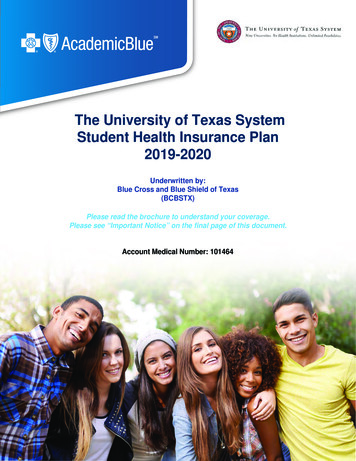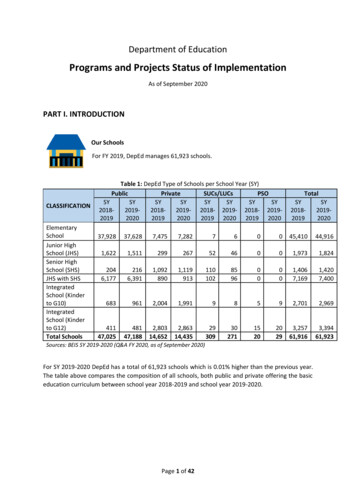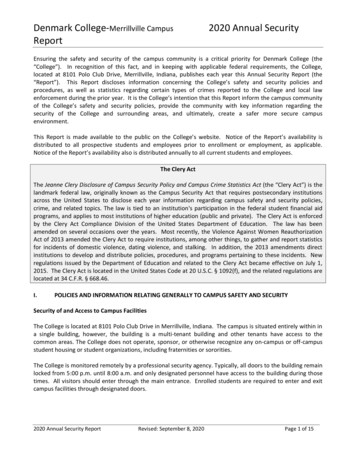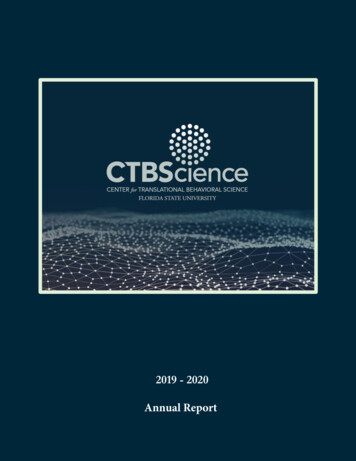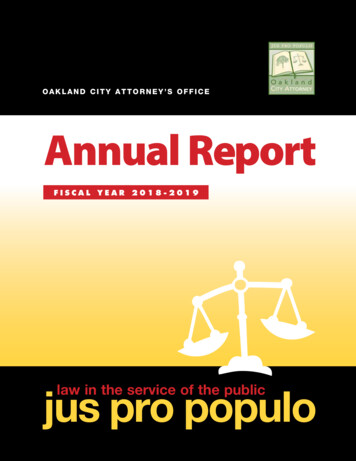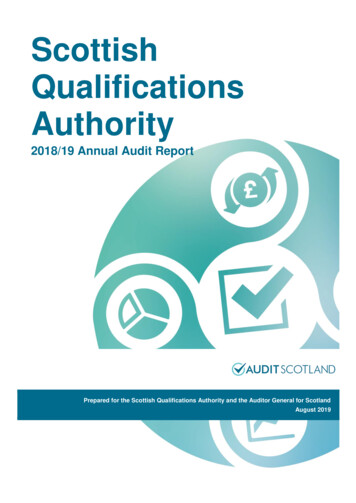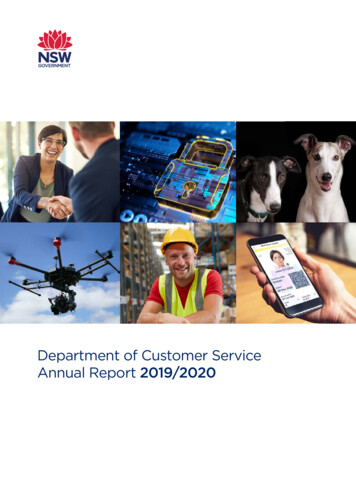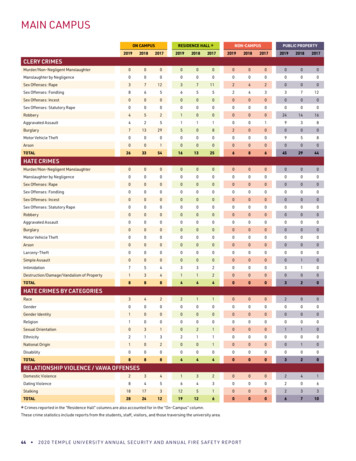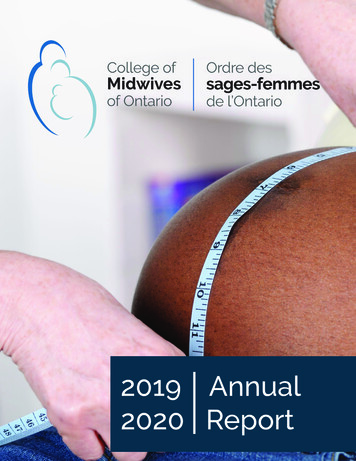
Transcription
2019 Annual2020 ReportAnnual Report 2019-2020 1College of Midwives of Ontario
Our VisionInspiring trust & confidence in midwiferyby leading in regulatory excellence.Our MissionRegulating midwifery in the publicinterest.Annual Report 2019-2020 2College of Midwives of Ontario
Table of ContentsPresident’s Letter4Registrar’s Letter 5Meet Your Council6Committees 7Strategic Plan & Guiding Principles 10Modernization of Legislation & Regulations11Implementation of Risk-based Regulation12Public Participation & Engagement16Discipline Summary19By The Numbers20Financial Statements28Annual Report 2019-2020 3College of Midwives of Ontario
President’s LetterThe relationship between a midwife and their client is a special one, and it was afterspending time teaching prenatal education to parents of multiples and forming abond with these parents that I was inspired to become a midwife. After graduatingfrom Ryerson University’s Midwifery Education Program in 2015, I decided to joinCouncil because I wanted to learn more about the College’s role in protecting thepublic interest through the regulation of the profession. While on Council, I was wellsupported by Council members and staff in my learning which is ultimately what influenced my decision to run for President in the fall of 2019. I believe strongly in theCollege’s mandate and am grateful to lead Council in achieving its goals.This past year on Council has been a very rewarding experience. As a Council, weensured that the College accomplished its planned initiatives in its Strategic Planand ensured there was minimal disruption to our work when the pandemic disrupted all of our personal and professional lives. In December, I was appointed Chair ofour Strategic Planning Working Group to help guide the development of our nextStrategic Plan. This exercise involves assessing any current or anticipated risksto achieving our mandate. It’s been a pleasure collaborating with peers, staff andstakeholders as part of this work and I look forward to sharing our plan with everyone once it is complete.On behalf of Council, I would like to offer my deep appreciation to each and everyone of you, whether you are a midwife, a family member caring for loved ones, orsimply practising physical distancing and wearing masks. Times have certainly notbeen easy, and I am proud to see that midwives continue to strive to provide excellent care to their clients, despite the pandemic.Please enjoy reading more about the College’s work over the next few pages.Regards,Claire Ramlogan-SalangaAnnual Report 2019-2020 4College of Midwives of Ontario
Registrar’s LetterLetterRegistrar’sWhile the world changed dramatically in the last quarter of our 2019-2020 fiscal year,the College’s role and mandate remained the same. In response to the emergence of theCOVID-19 virus, we quickly developed a Business Continuity Plan to ensure the work ofthe College would continue remotely with minimal interruption. The plan was implemented in mid-March upon the declaration of the pandemic, and I am grateful to allour staff, Council and Committee members for their hard work in making the transitionto work remotely while ensuring we continued to regulate in the public interest. I amalso grateful to our members and the public who were patient with us as we made necessary changes to our processes.Over the past year, and on a day-to-day basis, we continuously delivered on our statutory duties related to the registration of midwives, maintaining standards of the profession, supporting quality care and continuing competencies of midwives, and investigating matters related to the conduct of midwives. Additionally, we completed plannedinitiatives that supported our 2017-2020 Strategic Plan, specifically Modernizing Legislation and Regulations, Implementing Risk-based Regulation, and focussing on Public Participation and Engagement. Our activities are published in this Annual Report,and include the following few examples: changes to our Designated Drugs Regulation;conducting assessments of Midwife-Led Birth Centres using a new assessment framework and tools; launching a revised Peer and Practice Assessments Program; adoptinga Performance Measurement Framework to evaluate our effectiveness as a regulator;recruiting members of the public to our Committees as Public Non-Council CommitteeMembers, and; creating a policy to allow registrants or members of the public to address or present to Council.I am also pleased to provide you with the College’s 2019-2020 audited financial statements. This past year was our first fiscal year since our inception without a substantialoperational grant from the Ministry of Health. Special thanks to Council and staff whoensured that the College remained stable and became self-sufficient. I am grateful toall who contributed to our success.Sincerely,Kelly DobbinAnnual Report 2019-2020 5College of Midwives of Ontario
Meet Your CouncilProfessional Elected MembersTiffany Haidon, RM (term ended October 2019)Claudette Leduc, RM (as of October 2019)Lilly Martin, RMIsabelle Milot, RM (as of October 2019)Wendy Murko (term ended October 2019)Lisa Nussey, RMClaire Ramlogan-Salanga, RMMaureen Silverman, RMJan Teevan, RMEdan Thomas, RMAppointed Public MembersDeirdre BrettMarianna KaminskaJennifer Lemon (term ended April 2019)Susan “Sally” LewisJudith MurrayJohn StasiwNon-Council Appointed CommitteeMembers (Professional)Christi Johnston, RMClaudette Leduc, RM (term ended October2019)Amy McGee, RMIsabelle Milot, RM (term ended October 2019)Alexandra Nikitakis, RMNon-Council Appointed CommitteeMembers (Public)Jill EvansSamantha HeiydtAnnual Report 2019-2020 6College of Midwives of Ontario
CommitteesThe College’s seven statutory committees are mandated under the Regulated HealthProfessions Act, 1991. Reports are presented to Council on a quarterly and yearly basis and are included in Council meeting materials. Committees are made up of bothCouncil members and Non-Council Committee members, public and professional.ExecutiveQuality AssuranceTiffany Haidon, RM, President (term endedOctober 2019)Claire Ramlogan-Salanga, RM, President(as of October 2019)Edan Thomas, Vice-President, RM (Professional)Susan “Sally” Lewis, Vice-President (Public)Jan Teevan, RM, Professional-At-Large(until October 2019)Maureen Silverman, RM, Professional (as ofOctober 2019)Marianna Kaminska, Public (as of October2019)Lilly Martin, RM, ChairDeirdre BrettMarianna KaminskaSusan “Sally” Lewis (until October 2019)Isabelle Milot, RMClaire Ramlogan-Salanga, RM (until October2019)Maureen Silverman, RM (until October 2019)Jan Teevan, RMRegistrationIsabelle Milot, RM, ChairDeirdre Brett (until October 2019)Jill EvansSamantha HeiydtChristi Johnston, RMClaudette Leduc, RMJudith Murray (until October 2019)Alexandra Nikitakis, RMClaire Ramlogan-Salanga, RM (until October2019)John StasiwEdan Thomas, RM (until October 2019)ICRCEdan Thomas, RM, ChairJill EvansSamantha HeiydtChristi Johnston, RMClaudette Leduc, RMSusan “Sally” LewisLilly Martin, RMJudith MurrayWendy Murko, RM, Chair (term endedOctober 2019)Lisa Nussey, RM (until October 2019)Maureen Silverman, RMJohn Stasiw (until October 2019)Jan Teevan, RMAnnual Report 2019-2020 7College of Midwives of Ontario
CommitteesDisciplineClient RelationsSusan “Sally” Lewis, ChairJohn Stasiw, Chair (until October 2019)Claire Ramlogan-Salanga, RM (until October2019)Deirdre BrettMarianna KaminskaLilly Martin, RMWendy Murko, RM (term ended October 2019)Judith MurrayLisa Nussey, RMMaureen Silverman, RMJan Teevan, RMEdan Thomas, RMDeirdre Brett, ChairMarianna KaminskaAlexandra Nikitakis, RMLisa Nussey, RMJohn Stasiw (until October 2019)Fitness to PractiseSusan “Sally” Lewis, ChairJohn Stasiw, Chair (until October 2019)Deirdre BrettMarianna KaminskaLilly Martin, RMWendy Murko, RM (term ended October 2019)Judith MurrayLisa Nussey, RMClaire Ramlogan-Salanga, RM (until October2019)Maureen Silverman, RMJan Teevan, RMEdan Thomas, RMAnnual Report 2019-2020 8College of Midwives of Ontario
Annual Report 2019-2020 9College of Midwives of Ontario
Strategic Plan &Guiding PrinciplesThe College’s Strategic Plan is a high-level statement of the College’s mission, vision, outcomes and key priorities. It also identifies our guiding principles – the shared values thatunderpin our work as an organization and our relationships with the public, members andstakeholders.Our guiding principles are: Accountability: we make fair, consistent, and defensible decisionsTransparency: we act openly to enhance accountabilityIntegrity: we act with respect, fairness, and honestyProportionality: we allocate resources proportionate to the risk posed to our regulatoryoutcomesInnovation: we translate opportunity into organizational valueFrom 2017 to 2020, the College’s strategic priorities were: Modernization of the Legislation & RegulationsImplementation of Risk-based RegulationPublic Participation & EngagementAnnual Report 2019-2020 10College of Midwives of Ontario
Modernization of Legislation& RegulationsAs part of the College’s strategic priority of modernizing midwifery legislation and regulations, the College completed its annual work aimed at improving the quality of midwiferyregulation and removing unnecessary regulatory barriers and burdens in order to enhanceregulatory effectiveness, transparency, flexibility and innovation.Please read below to see the College’s accomplishments.Designated Drugs RegulationThe Designated Drugs Regulation madeunder the Midwifery Act, 1991 outlines thedrugs and substances authorized to midwives.In May 2019, the College was asked byHealth Minister Christine Elliott to amendits Designated Drugs Regulation to includecategories of drugs in accordance with theAmerican Health Formulary System (AHFS).Although this request did not support theCollege’s previous submission for broadprescribing authority, the College felt thatthe Ministry-proposed approach wouldnevertheless bring positive change as midwives and their clients would have improvedaccess to up-to-date treatments.The College undertook this work and proposed a regulation that included categoriesof drugs and substances in accordance withthe AHFS categories, as per the Minister’srequest. The proposed regulation was sup-ported by Council at the September 2019meeting and circulated immediately for a60-day public consultation. The approvedregulation was submitted to the Ministrybefore the December 31, 2019, deadline.In order to effectively implement the revised regulation and to ensure that any risksare mitigated, the College also proposedmaking it a condition of registration thatall members and midwifery applicants successfully complete a mandatory trainingcourse approved by Council relating to thesafe, effective and ethical prescription andadministration of controlled substances. Atthe March 2020 Council meeting, Councilapproved a mandatory training course onprescribing and administering opioids andbenzodiazepines that midwives and applicants will be required to complete.The College is currently waiting for theMinistry to advise of next steps.Annual Report 2019-2020 11College of Midwives of Ontario
Implementation ofRisk-based RegulationRisk-based regulation means that the day-to-day activities of the College are guided byfocussing activity and attention on issues that pose the greatest risk to clients and members of the public. The College does not seek to eliminate risk completely, but to make thebest use of its limited resources to proactively reduce the risks posed to an acceptable level.The College has worked throughout the year to enhance organizational capacity to deliverrisk-based regulation effectively and efficiently, and to ensure responsiveness and transparency of our regulatory approach. Read about this work over the next few pages.HIROC Risk Assessment ChecklistProgramThe College’s Registration, ProfessionalConduct and Operations departments completed the final year of a three-year RiskAssessment Checklist program, developedand administered by the Healthcare Insurance Reciprocal of Canada (HIROC).It is a voluntary self-assessment programthat aims to improve the College’s internalprocesses and systems in the following areas: registration and licensure; complaintsand resolutions; appropriate release of information or denial to release information;privacy; wrongful dismissal; and employeefraud.Birth Centre AssessmentsActing on behalf of the Ministry of Health,one of the College’s duties is to administer assessments of the two Ontario Mid-wife-Led Birth Centres (MLBC) licensedunder the Independent Health Facilities Act,1990 (IHFA). In accordance with s.27 of theIHFA, and at the request of the Director ofthe Independent Health Facilities Branch ofthe Ministry of Health, the College is required to conduct these assessments everyfive years and is also responsible for settingthe Facility Standards and Clinical PracticeParameters (FS & CPP) which serves as thebasis for these assessments.This past year, the College carried out anassessment of the quality and standards ofservices at the Ottawa Birth and WellnessCentre (OBWC). The OBWC was providedwith a self-assessment tool in December2019 and was required to submit evidenceof meeting the standards as outlined in theCollege-approved FS & CPP.Selected assessors were trained by the College to conduct the assessment in a fair andimpartial manner and in accordance withAnnual Report 2019-2020 12College of Midwives of Ontario
our policies and procedures. Two assessorsreviewed the submission and conductedan on-site assessment in February 2020.Results of the successful assessment werecommunicated to the OBWC and a final report was submitted by the Registrar to theDirector of the Independent Health Facilities Branch in March 2020.Peer & Practice Assessment ProgramThe College’s revised Peer & Practice Assessment Program was successfullylaunched in January 2020. Twelve trainedassessors delivered distance assessmentsto 79 randomly selected midwives, representing approximately 10% of the practisingmidwives. Midwives who indicated scoresof 75% or above in the distance assessment were streamed out of the process andnot required to participate in a subsequentin-person assessment. Their names werealso removed from the assessment selectionpool for five years. Read about the results ofthese assessments on page 25 of this report.Prescribing and Administering DrugsStandardThe Prescribing and Administering DrugsStandard (Standard) describes the College’sexpectations regarding the prescribing andadministration of drugs. This Standard setsout the conditions for safe prescribing, appropriate record keeping, and informationthat a midwife must include in a prescription. The Standard also included Appendix1, which repeated the list of drugs outlinedin the Designated Drugs Regulation (O. Reg884/93) and also applied a restriction to theuse of oxytocin to the postpartum periodonly.The College determined that the Standarddid not accurately reflect the midwiferyscope of practice. Induction and augmentation of labour is considered to be in themidwifery scope of practice and the drugused for this purpose is authorized to mid-wives in the Designated Drugs Regulationwithout restriction.Accordingly, Appendix 1 was rescinded atthe October 2019 Council meeting allowing midwives to work in accordance withthe scope of practice and Designated DrugsRegulation, therefore permitting midwiveswho had the necessary knowledge, skill andjudgment to administer and manage oxytocin inductions and augmentations on theirown authority.Standards of Practice ReviewIn 2016, the College adopted a risk-basedapproach to regulation which required a review of all existing standards. College staffproposed a two-phased method in order toalign all standards with this approach andStage I was completed in June 2018 whenthe College implemented the ProfessionalStandards for Midwives and rescinded 25standards.This past year, the College completed workthat was a part of Stage II of the review.This work included conducting a surveywith members on the Consultation andTransfer of Care Standard (CTCS) in orderto understand how the CTCS contributespositively and negatively to interprofessional relationships and safe care. This surveyprovided the College with the information itneeded to recommend to Council to rescindthe CTCS once it is replaced by a Scope ofPractice Guide. This approach was approvedfor consultation by Council at the March2020 meeting.This draft Guide outlines the midwiferyscope of practice and authorized acts and isa helpful tool for midwives to better understand the regulatory framework in whichthey work.In March, Council approved the draft Scopeof Practice Guide for broad consultationamongst members, stakeholders, and mem-Annual Report 2019-2020 13College of Midwives of Ontario
bers of the public. However, the consultation was delayed due to the COVID-19 pandemic.tion and assist members with their understanding of College requirements or legalobligations imposed by other authorities.Regulatory Performance MeasurementFrameworkThe Guide on Mandatory & PermissiveReporting outlines circumstances wheremidwives (including practice partners andassociates), employers of midwives and operators of facilities where midwives practiseare required to file a mandatory report withthe College under the Regulated Health Professions Act, 1991 (RHPA), the College’s Registration Regulation and College By-laws. Italso addresses instances where reporting tothe College is not mandatory but is permissive.As part of the College’s commitment toregulatory excellence, a Regulatory Performance Measurement Framework was developed to objectively evaluate our regulatoryperformance. While not legislatively mandated, the College made a voluntary commitment to evaluate our performance and todemonstrate our success in regulating in thepublic interest.This framework allows the College to review, evaluate and report on its performance using a set of standards that arebased on our legislative mandate and expected outcomes. The framework describesthe outcomes the College is expected toachieve in four broad domains: RegulatoryPolicy; Suitability to Practise; Openness andAccountability; Good Governance.The College completed a pilot year to testthe framework and will undertake and report on a comprehensive assessment nextyear.Guide on Mandatory & PermissiveReportingAs part of the College’s planned initiativesto develop regulatory guidance for membersbased on the identification of risks (or gaps)arising out of complaints trends and changes made to governing legislation/regulations, the College initially developed a Guideon Mandatory Reporting, but after revisionswere made to improve the Guide this pastyear it was re-titled the Guide on Mandatory and Permissive Reporting.In general, the College develops guides tooutline procedures and actions related to anactivity covered in the legislation or regulaAnnual Report 2019-2020 14College of Midwives of Ontario
Annual Report 2019-2020 15College of Midwives of Ontario
Public Participation &EngagementPublic engagement is the process of actively bringing the voices of the public and clientsinto decisions that are relevant to them. The decisions may be relevant to the public eitherbecause they have an interest in the issues being discussed, or because they are directlyaffected by the decision being made. Regardless of the motivation, the key to engagementis giving people who want to contribute the opportunities to do so.The College is using a Ladder of Engagement in order to build awareness and create connections with members of the public. This ladder is outlined in the College’s Public Engagement Strategy and consists of four rungs: Awareness; Information; Participation;Collaboration. Through this method we are able to reach members of the public who areinterested in the work of the College and who want to be involved further.Please read below about the College’s public engagement initiatives from this year.Public Non-Council CommitteeMembersAs part of the College’s strategic objectiveof increasing public participation and engagement, in the fall of 2019, it sought torecruit members that would serve as PublicNon-Council Committee Members on theCollege’s Committees.The College’s Public Engagement Strategy categorizes this type of initiative in theCollaboration rung on the Ladder of Engagement, as the public members are decision-makers.Two positions were filled in 2019.By having members of the public serve inthese positions, it allows them to becomedecision makers and work as equal partners with the College. This initiative helpsdemonstrate to the public that we are fullyaccountable to them by adding members ofthe public to our governance structure.Annual Report 2019-2020 16College of Midwives of Ontario
Addressing or Presenting to CouncilPolicyWhat to Expect from Your Midwife Brochure (French)The Governance Process Policy on Addressing or Presenting to Council was approvedat the October 2019 Council meeting andallows members of the public to address theCollege’s Council at its open meetings. Thispolicy was created to outline a clear processto support opportunities for public engagement, while also establishing parametersthat mitigate any potential risks to Council’sdecision-making process and public interestmandate.In early 2019, the College released its brochure, What to Expect from Your Midwife,that was created to help educate membersof the public of their rights and expectationsof being in midwives’ care. This past fiscalyear, the College translated this brochureinto French in order to better reach theFrench speaking population in Ontario. Thisbrochure is available for free on the College’s website as a PDF and can be orderedat no cost for all midwifery practice groupsin Ontario.Prior to this recommendation, there was nomechanism whereby individuals were ableto address or present to Council in a fair orconsistent manner. By developing and approving the Governance Process Policy onAddressing or Presenting to Council, theCollege continues to work towards adopting an effective public engagement programthat allows active public participation andengagement and provides sufficient opportunities for the public to impact decisions.This brochure falls under the Informationrung on the College’s Ladder of Engagementas it is a one-way sharing of informationfrom the College to the public.This initiative falls under the Participationrung of the College’s Ladder of Engagementand explains that at this stage members ofthe public are involved in two-way conversation with the College.Annual Report 2019-2020 17College of Midwives of Ontario
Annual Report 2019-2020 18College of Midwives of Ontario
Discipline SummaryWhen a midwife has been referred by the Inquiries, Complaints and Reports Committeebecause of the serious nature of the alleged professional misconduct and/or incompetence,the Discipline Committee holds a hearing.Read below for a summary from the College’s discipline case from the past year.Discipline SummaryA panel of the Discipline Committee (the“Panel”) held a public hearing for NasrinBandari Vali on November 23, 2019. Thehearing was uncontested and proceeded byway of Agreed Statement of Facts and JointSubmission on Penalty.The Panel found that Ms. Bandari Vali committed acts of professional misconduct, inthat she had failed to maintain a standardof practice of the profession, and engagedin an act or omission relevant to the practice of the profession that, having regard toall the circumstances, would reasonably beregarded by members as unprofessional.The Panel ordered that Ms. Bandari Valiappear before a panel of the DisciplineCommittee to be reprimanded, with the factof the reprimand to appear on the PublicRegister. At the conclusion of the hearing,Ms. Bandari Vali waived her right to appealand the reprimand was administered. ThePanel also directed the Registrar to suspendMs. Bandari Vali’s certificate of registrationfor a period of one month and to impose thefollowing terms, conditions or limitationson Ms. Bandari Vali’s certificate of registration which required her to complete: A course relating to the managementof preterm labour, preterm pre-labourrupture of membranes and pre-labourrupture of membranes (PPROM); A 1,500-word reflective paper on thediagnosis and management of the intrauterine growth restriction andsmall-for-gestational-age fetuses, including a discussion on screening for riskfactors; Practise under indirect supervision fora period of six months, which includesconsulting with an approved supervisorregarding any clients who report signsor symptoms of PPROM, PROM, pretermlabour, or decreased fetal movement; andparticipating in regular chart reviews.The Panel also ordered Ms. Bandari Vali topay costs to the College in the amount of 3,500.00.For more information, the full decision ofthe Panel can be found on our website.Annual Report 2019-2020 19College of Midwives of Ontario
By The NumbersAnnual Report 2019-2020 20College of Midwives of Ontario
Annual Report 2019-2020 21College of Midwives of Ontario
Annual Report 2019-2020 22College of Midwives of Ontario
Annual Report 2019-2020 23College of Midwives of Ontario
Annual Report 2019-2020 24College of Midwives of Ontario
Annual Report 2019-2020 25College of Midwives of Ontario
Annual Report 2019-2020 26College of Midwives of Ontario
Annual Report 2019-2020 27College of Midwives of Ontario
FinancialsAnnual Report 2019-2020 28College of Midwives of Ontario
Annual Report 2019-2020 29College of Midwives of Ontario
Annual Report 2019-2020 301College of Midwives of Ontario
Annual Report 2019-2020 312College of Midwives of Ontario
Annual Report 2019-2020 323College of Midwives of Ontario
Annual Report 2019-2020 334College of Midwives of Ontario
Annual Report 2019-2020 345College of Midwives of Ontario
College of Midwives of Ontario21 St. Clair Avenue EastSuite 303Toronto, OntarioM4T 1L9T: 416.640.2252 / 1.844.640.2252F: 416.640.2257cmo@cmo.on.caAnnual Report 2019-2020 35College of Midwives of Ontario
from Ryerson University's Midwifery Education Program in 2015, I decided to join . ed all of our personal and professional lives. In December, I was appointed Chair of . fession, supporting quality care and continuing competencies of midwives, and investi-gating matters related to the conduct of midwives. Additionally, we completed planned
